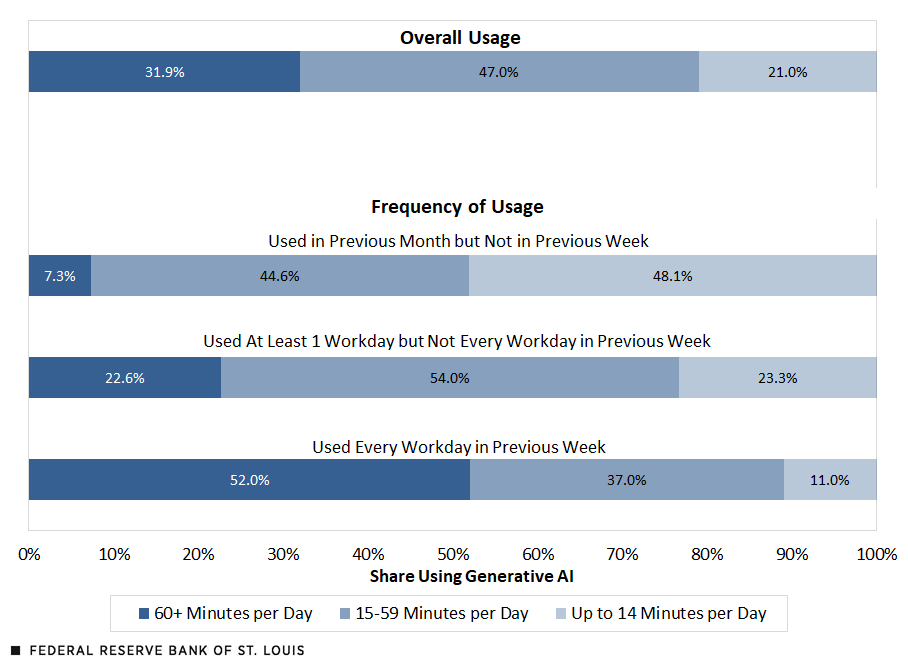Generative artificial intelligence (AI) has rapidly become a promising workplace technology. A study, based on surveys conducted in the U.S., explores the potential productivity gains from its adoption.
In an earlier blog post, the study discussed the results of the first nationally representative U.S. survey of generative AI adoption, conducted in August 2024, and found that 28% of all workers used generative AI at work to some degree. A follow-up survey in November 2024 showed that usage rates remained fairly stable. This blog post analyzes data from the November survey to estimate the potential aggregate productivity gains from generative AI.
For more details, see the updated working paper, “The Rapid Adoption of Generative AI,” Federal Reserve Bank of St. Louis Working Paper 2024-027C, revised February 2025.
How Much Work Is Assisted by Generative AI?
To measure the impact of generative AI on productivity, the study assessed workers’ reliance on this technology. Surveys asked respondents about the frequency and duration of generative AI use. Data from August and November 2024 showed that 9% of U.S. workers used generative AI every workday in the previous week, and 14% used it for at least one day but not every day.

Among workers who used generative AI at least once in the previous month, nearly one-third (31.9%) spent an hour or more per workday using it, while another 47.0% used it between 15 and 59 minutes daily. There is a positive correlation between frequency of use and time spent using the technology. For example, 52.0% of generative AI users employing this technology every workday also reported using it an hour or more daily, compared with only 7.3% of those who used it in the previous month but not the previous week.
Using information on days and hours worked, the study estimated the share of total work hours assisted by generative AI. Among workers who used the technology in the previous week (21.8% of all workers), between 6.0% and 24.9% of all work hours were assisted by generative AI. This indicates that, on average, generative AI is an integral part of its users’ work routines. Examining all workers, including those who used it only in the previous month and non-users, between 1.3% and 5.4% of total work hours were assisted by generative AI.
Time Savings and Productivity Gains
To quantify productivity benefits, the study asked November 2024 survey respondents how much additional time they would have needed to complete the same amount of work if they hadn’t been able to use generative AI. The survey question was: “You indicated that LAST WEEK you worked X hours and that you used Generative AI for your job. Now, imagine that LAST WEEK you did not have access to Generative AI. How many additional hours of work would you have needed to complete the same amount of work?”
The responses indicate that users save a significant amount of time. Among workers who used generative AI in the previous week, 20.5% said it saved them four or more hours in that week, 20.1% reported three hours saved, 26.4% reported saving two hours, and 33.0% reported saving an hour or less.

More-frequent users reported greater time savings. Among those who used generative AI every day in the previous week, 33.5% said it saved them four or more hours, compared with 11.5% of those who used it only one day in that week.
The study computed the percentage of work hours saved. The average time savings was 5.4% of work hours in the November 2024 survey, which translates to 2.2 hours per week for an individual working 40 hours. When factoring in all workers, the technology saved 1.4% of total hours.
Usage and Time Savings: Occupations and Industries
The study found a correlation between generative AI usage and time savings across occupations. Workers in computer and mathematics occupations used generative AI in nearly 12% of their work hours and reported 2.5% time savings. Conversely, workers in personal service occupations used the technology in only 1.3% of their work hours, saving only 0.4% of work time.

Across industries, information services showed the largest share of work hours using generative AI (14.0%) and the highest time savings (2.6%). Leisure, accommodation, and other services had both the lowest generative AI use (2.3%) and lowest time savings (0.6%).

In our working paper, we used a standard model of aggregate production, and showed how we could use our data on hours worked, hourly wages and time savings from generative AI to provide a rough estimate of the aggregate productivity gain from that new technology. Together, the model and data imply that the self-reported time savings from generative AI translate to a 1.1% increase in aggregate productivity. Using our data on generative AI use, this estimate implies that, on average, workers are 33% more productive in each hour that they use generative AI.
This estimate aligns with the average estimated productivity gain from several randomized experiments on generative AI usage.
Potential Gains May Not Yet Be Fully Captured in Measured Productivity
While the study documented significant time savings from generative AI, how these gains translate into aggregate productivity remains uncertain. It is possible that some workers are completing their tasks faster, and using their saved time in less productive ways. The study cites a 2024 working paper by Kathryn Bonney and others who found that only 5.4% of firms had formally adopted generative AI as of February 2024. With individual adoption outpacing formal adoption, these potential productivity gains may not immediately appear in productivity statistics.
Future research should examine how companies adjust their expectations and work processes in response to widespread AI adoption. As more companies integrate AI into their operations, these gains may materialize more clearly in aggregate productivity measures. The extent to which AI reshapes the labor market and how it affects wages are crucial open questions.
Notes
For more details, see our updated working paper, “The Rapid Adoption of Generative AI,” Federal Reserve Bank of St. Louis Working Paper 2024-027C, revised February 2025.


